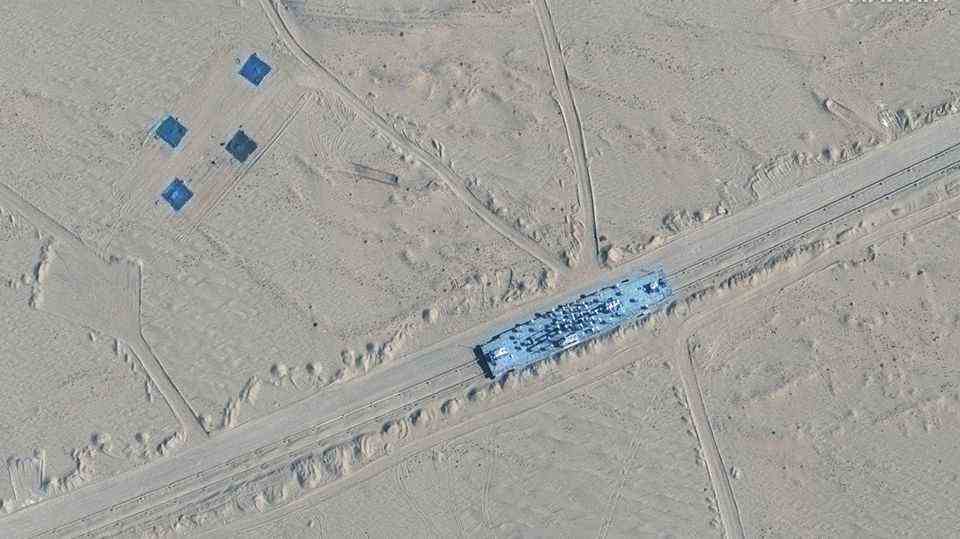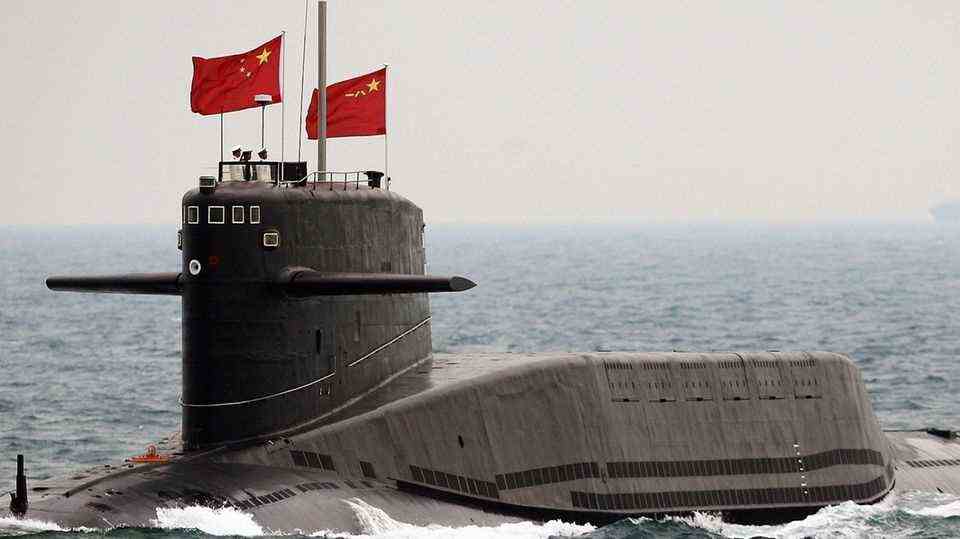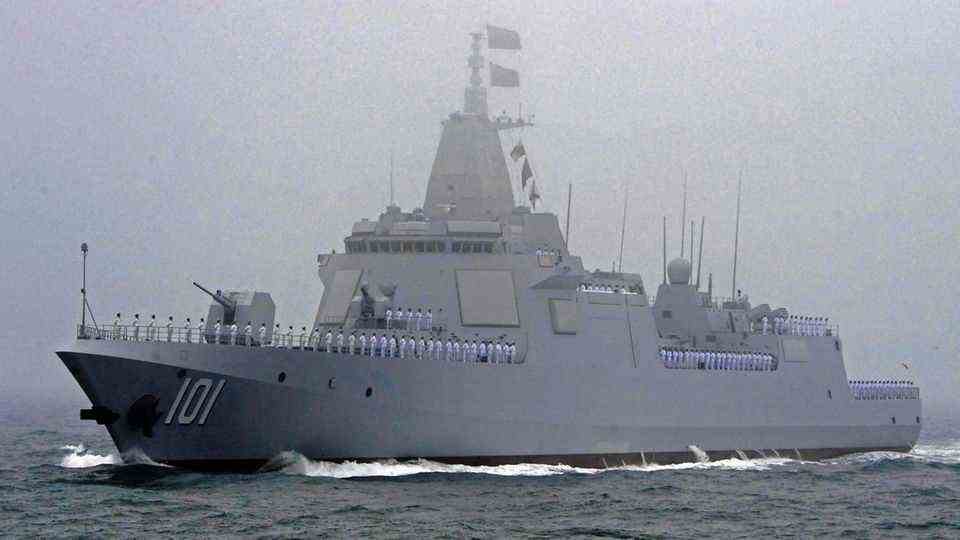Armament
US aircraft carrier as a target: Beijing wants to use carrier killers to break the USA’s supremacy at sea
See in the video: US satellite images show dummy ships in the desert: China may be training attacks.
The aircraft carriers secure the military world power of the USA – Beijing is after them. Beijing’s carrier killers are to be tested on giant models – they can attack US ships from 3,600 kilometers away.
The Chinese military has built huge “targets” in the Taklamakan Desert that resemble American aircraft carriers and destroyers. Contrary to what has been reported in the media, the replicas are indeed very large, but still not on a scale of 1 to 1. They are smaller versions of the real ships – one object is 75 meters long. The dummies are moved through the desert on a 6 meter wide rail.
The shape of the ships can be seen clearly from above on the satellite images. The dummies are worked out to different extents. Some of them have a bare deck – the aircraft carrier does not even have a structure for the navigating bridge – surface structures can already be seen on others.
Known opponents
The excitement about these structures is somewhat hypocritical. Even when “blue” and “red” are spoken of in maneuvers, all powers are preparing for probable conflicts. During maneuvers in the Baltic States and Poland, you can confidently translate your opponent into Russia. Equally self-evident is the effort to obtain weapon systems for exercises that are similar to those of the suspected opponent. For this purpose, the USA maintained a squadron of USSR aircraft during the Cold War. What is new is that China is now also doing something similar. The sheer dimension of the objects and the weapon systems for which the shooting range in the desert is intended are also new.
The target are the sponsoring groups
It shows how much China is focused on combating US carrier groups. Because the replicas of the rocket destroyers from the Arleigh Burke class are also used to combat the security of such an association. The world power of the USA is based on these carrier groups. It enables the United States to concentrate enormous military power at any point in the world in a short space of time. The carriers then reinforce the network of US military bases around the world.
These carrier groups have been unchallenged since 1945 – but this is also due to the fact that the USA has always chosen opponents of the war who lagged far behind in terms of military technology and had no chance of attacking a carrier. But the porters were never invulnerable, in exercises submarines managed several times to bring themselves to a carrier in the final position. More than 100 aircraft on a ship concentrate an enormous firepower, but the disadvantage is obvious: only a single heavy hit, even from a conventional weapon, can sink an entire carrier.
Moving targets
And that is exactly what is supposed to be practiced in the Taklamakan Desert in central China. Missiles can attack a carrier from a long distance. They are launched outside the carrier group’s defensive ring. From ships or airplanes, China has even developed an assisted ballistic missile for this purpose. The concept of long-range missiles has great advantages for the attacker. The greater the range, the greater the exclusion zone that you set up and the more safely it can be started. For comparison. In the Falklands War, the Argentines attacked the British federation. The Dassault Super Étendard fighter-bombers had to approach the fleet in extremely low flight and fired their missiles from a distance of only 46 kilometers.
Beijing, on the other hand, has anti-ship missiles with a range of almost 4,000 kilometers. There is only one problem with this: the projectiles have to hit the target. A carrier moves quickly and changes course unpredictably – this means that when a missile is launched, it is not possible to determine its position at the time of impact. It’s a completely different task than taking out a bunker. The carrier has to be tracked down, its target data has to be transmitted to the launch unit and on the final approach the warhead itself has to find and control the moving carrier. And that is exactly what is to be simulated with the large exercise targets, and for this they have to be moved at considerable speed on the rail system in the desert.
The geographic information company AllSource Analysis, which identified the location using satellite images, writes that the deserted area has traditionally been used for ballistic missile tests. AllSource Analysis: “The dummies of several likely US warships as well as other warships (rail and mobile) could simulate targets associated with seek / targeting tests. This and the extensive details of the dummies, including the placement of multiple sensors on and around them the ship’s targets suggest that this area will be used several times over the course of time. “

A scene like from a surrealistic film: a ship moves in the middle of the desert
© Maxar / PR
Beijing’s arsenal
China has several anti-ship ballistic missile programs. Ballistic means: The rocket rises into nearby space and from there one or more re-entry bodies crash towards the earth. What is new today is that these entry bodies are steerable and can change their course. This is the only way they can reach a mobile destination such as a porter. The land-based rocket DF-21D has a range of over 1500 kilometers, the larger DF-26 even 3700 kilometers. The DF-26 could attack and sink a carrier formation in much of the Pacific long before its aircraft can reach mainland China.
“The DF-26 multipurpose missile is designed to swiftly swap conventional and nuclear warheads and is capable of precision land and anti-ship attacks in the western Pacific, Indian Ocean and South China Sea from mainland China. In 2020 has fired anti-ship ballistic missiles at a moving target in the South China Sea, “the report said.
In addition to the land-based missiles, the largest air-launched missile in the world, the CH-AS-X-13, was developed for the old H-6 bomber. She will carry a maneuverable hypersonic warhead. At the same time, Beijing is building a large fleet of Type 055-class missile destroyers. Because of their size and combat power, the ships trade as “cruisers” – they too can carry ballistic anti-ship missiles. Type 055 is considered the most modern ship of its kind.
It is not yet known which weapons will be tested in which way on the facility. It is only obvious that the models of the US ships are intended to provide the simulation of a target. By adapting the structures, it is possible to generate a realistic radar echo. The effort to build targets almost a hundred meters in size is certainly considerable. However, one must not forget that it is just a kind of empty shell that is mounted on a rack. The correct radar shadow is created by a suitable coating. Signatures of sounds and electronics are created artificially.
It is also likely that the dummy targets can be equipped with electronic defensive measures that make target acquisition more difficult. Presumably, all of this will remain in the range of a simulation, because a hit with a sharp warhead would of course destroy the complex models. At the same time, Beijing will continue to test its systems with training ships.
Source: USNI





